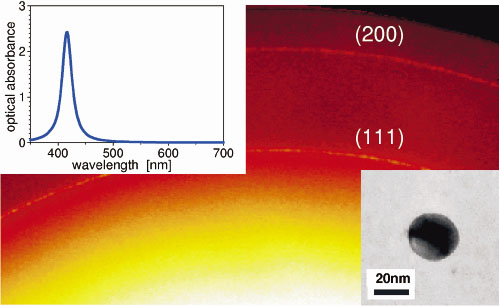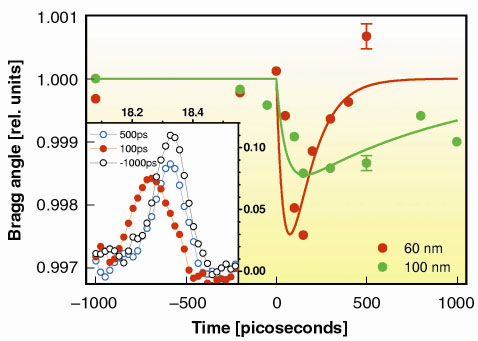- Home
- Users & Science
- Scientific Documentation
- ESRF Highlights
- ESRF Highlights 2001
- Surfaces, Interfaces and Nano-science
- Picosecond Pump-and-probe Studies of Photo-excited Silver Nanoparticles
Picosecond Pump-and-probe Studies of Photo-excited Silver Nanoparticles
Nanocrystal assemblies [1] possess intriguing properties for novel material applications. Metal nanoparticles are used for fast optical applications such as light switching, or for three-dimensional micro patterning. Finite-size effects, such as particle-plasmon resonances, determine the optical properties. These resonances in the visible spectrum can be tailor-made through shape variation. A series of ultrafast energy-relaxation processes is observed after excitation with femtosecond laser pulses. These comprise plasmon decay, electron gas heating and lattice expansion through electron phonon coupling. Two channels of lattice reaction are excited, an incoherent heating of the particles which cool down through interaction with the matrix in hundreds of picoseconds and a coherent nuclear motion described as (acoustic) phonons or shape oscillations with frequencies in the picosecond range.
From optical spectroscopy [2] the nuclear motion can be modelled under a free particle approximation, but no clear distinction of the strain or disorder state of the lattice can be made. Therefore X-ray diffraction is used here to focus on the lattice dynamics of laser-excited silver particles in a glass matrix. At ID09TR a time-resolved pump-and-probe setup is realised allowing a study of the lattice reaction to a femtosecond laser pulse at 400 nm with a fixed time delay with picosecond accuracy in a stroboscopical mode. We collected the powder diffraction from embedded silver particles of sizes from 20 to 100 nm on a MarCCD. The shift of the size-broadened (111) Debye-Scherrer ring allows us to resolve lattice expansions in the range of 2x104 (Figure 66).
 |
Fig. 66: Powder pattern from silver particles in a matrix. The (111) reflection of the fcc lattice is used for the tracking of the lattice dynamics. The insets show a TEM micrograph (lower) and the plasmon resonance curve in the optical spectrum (upper). |
Figure 67 displays the shift of the (111) ring to lower angles immediately after the laser impact. This shows the presence of an expanded lattice. Following the Bragg angle shift with the delay time between X-ray and laser pulse, one can clearly determine the cooling rate of the particles by heat transfer to the matrix. As for the larger particles (100 nm diameter) the surface to volume ratio is smaller, the cooling rate is considerably lower than for the particles of 60 nm diameter (150 ps vs. 970 ps decay time). Under the assumption of a bulk expansion coefficient one can deduce a maximal jump of the lattice temperature of 140 K for the 60 nm particles. Yet the distinction between coherent motion and thermal expansion is not obvious and a line profile analysis can give additional information.
 |
Fig. 67: Shift of the Bragg angle as function of the delay time between laser excitation and X-ray probe. The onset time is determined by the temporal resolution of the X-ray pulse (80 ps), whereas the decay of the transient reflects the heat transfer to the surrounding matrix. The inset displays the line profiles at different delay times for the 60 nm particles. |
In conclusion, we could resolve the transient expansion of nanoparticles triggered by a short laser pulse. The parameters of the heat transfer can serve as a valuable absolute determination of lattice temperature and may help to identify the coherent contribution to the motion.
References:
[1] M. Kaempfe, T. Rainer, K.J. Berg, G. Seifert and H. Graener, Appl. Phys. Lett. 74, 1200 (1999).
[2] M. Perner, S. Grésillon, J. Maerz, G. von Plessen and J. Feldmann, J. Porstendorfer, K.-J. Berg and G. Berg; Phys. Rev. Lett. 85, 792 (2000).
Principal Publication and Authors:
A. Plech (a), S. Grésillon (b), G. von Plessen (c), S. Kuerbitz (d), K.J. Berg (d), M. Kaempfe (d), H. Graener (d) and M. Wulff (a), submitted.
(a) ESRF
(b) ESPCI, Paris (France)
(c) Sektion Physik der LMU München (Germany)
(d) FB Physik der MLU Halle (Germany)



